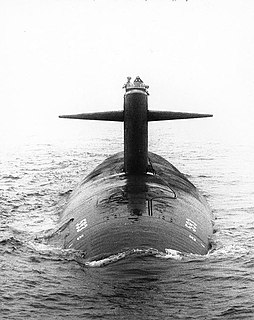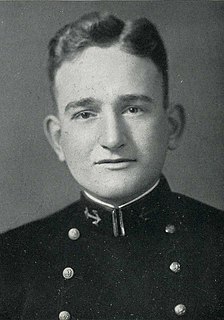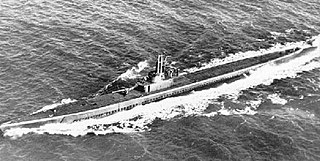
The Mare Island Naval Shipyard (MINSY) was the first United States Navy base established on the Pacific Ocean. It is located 25 miles northeast of San Francisco in Vallejo, California. The Napa River goes through the Mare Island Strait and separates the peninsula shipyard from the main portion of the city of Vallejo. MINSY made a name for itself as the premier US West Coast submarine port as well as serving as the controlling force in San Francisco Bay Area shipbuilding efforts during World War II. The base closed in 1996 and has gone through several redevelopment phases. It was registered as a California Historical Landmark in 1960, and parts of it were declared a National Historic Landmark District in 1975.

The Gato class was a class of submarines built for the United States Navy and launched in 1941–1943; they were the first mass-production U.S. submarine class of World War II. Together with their near-sisters the Balao and Tench classes, their design formed the majority of the United States Navy's World War II submarine fleet. Named after the lead ship of the class, USS Gato, the Gatos and their successors formed the core of the submarine service that was largely responsible for the destruction of the Japanese merchant marine and a large portion of the Imperial Japanese Navy in World War II. Gato's name comes from a species of small catshark. Like most other U.S. Navy submarines of the period, boats of the Gato class were given the names of marine creatures. In some references, the Gatos are combined with their successors, especially the Balao class.

USS Marlin (SST-2), originally USS T-2 (SST-2), was a T-1-class training submarine in commission from 1953 to 1973. She was the second submarine of the United States Navy to be named for the marlin, a large game fish. Except for the first 25 early development pre-WWI subs, she was one of the smallest operational submarines ever built for the U.S. Navy.

USS Greenling (SSN-614), a Permit-class submarine, was the second ship of the United States Navy to be named for the greenling, an elongate, fine-scaled fish found from Kamchatka to California. Her keel was laid down on 15 August 1961 by the Electric Boat Company of Groton, Connecticut.

Richard Hetherington "Dick" O'Kane was a United States Navy submarine commander in World War II, who was awarded the Medal of Honor for commanding USS Tang to the most successful record of any United States submarine ever. He also received three Navy Crosses and three Silver Stars, for a total of seven awards of the United States military's three highest decorations for valor in combat. Before commanding Tang, O'Kane served in the highly successful USS Wahoo as executive officer and approach officer under noted Lieutenant Commander Dudley "Mush" Morton. In his ten combat patrols, five in Wahoo and five commanding Tang, O'Kane participated in more successful attacks on Japanese shipping than any other submarine officer during the war.

USS Robalo (SS-273), a Gato-class submarine, was the only ship of the United States Navy to be named for the róbalo or common snook. Her keel was laid down on 24 October 1942 by the Manitowoc Shipbuilding Company at Manitowoc, Wisconsin. She was launched on 9 May 1943, sponsored by Mrs. E.S. Root, and commissioned on 28 September 1943.

The Permit-class submarine,, was a class of nuclear-powered fast attack submarines in service with the United States Navy from the early 1960s until 1996. They were a significant improvement on the Skipjack class, with greatly improved sonar, diving depth, and silencing. They were the forerunners of all subsequent US Navy SSN designs. They served from the 1960s all the way through to the early 1990s, where they were decommissioned due to age. They were followed by the Sturgeon and Los Angeles classes.
A nuclear submarine is a submarine powered by a nuclear reactor. The performance advantages of nuclear submarines over "conventional" submarines are considerable. Nuclear propulsion, being completely independent of air, frees the submarine from the need to surface frequently, as is necessary for conventional submarines. The large amount of power generated by a nuclear reactor allows nuclear submarines to operate at high speed for long periods of time; and the long interval between refuelings grants a range virtually unlimited, making the only limits on voyage times being imposed by such factors as the need to restock food or other consumables.

USS Jack (SSN-605), a Permit-class submarine in commission from 1967 to 1990, was the second ship of the United States Navy to be named for the jack, a name of fish applied to any young pike, large California rockfish, or green pike or pickerel. She saw extensive service during the Cold War.

USS Hoe (SS-258), a Gato-class submarine, was a ship of the United States Navy named for the hoe, one of various sharks, especially the dogfish.

USS Lapon (SS-260), a Gato-class submarine, was the first ship of the United States Navy to be named for the lapon, a scorpionfish of the Pacific coast of the United States.

George William Grider was a United States Navy Captain, an attorney, and a Democratic U.S. Representative from Tennessee from 1965 to 1967.
Flasher has multiple meanings:

Battleship Memorial Park is a military history park and museum located on the western shore of Mobile Bay in Mobile, Alabama. It has a collection of notable aircraft and museum ships including the South Dakota-class battleship USS Alabama and Gato-class submarine USS Drum. USS Alabama and USS Drum are both National Historic Landmarks; the park as a whole was listed on the Alabama Register of Landmarks and Heritage prior to that time, on October 28, 1977.
Kenneth Monroe Carr was a U.S. Navy vice admiral who was Deputy and Chief of Staff to the Commander in Chief Atlantic Command and the Commander in Chief of the U.S. Atlantic Fleet. He retired from the navy on May 1, 1985. He became Chairman of the U.S. Nuclear Regulatory Commission on July 1, 1989 having been a member of the Commission since August 14, 1986.
United States Submarine Operations in World War II by Theodore Roscoe is a classic history of the role of the United States Navy submarines in World War II, earning him the title of "grandfather" of World War II American Submarine historiography. Because the book was written shortly after the war, later scholars have found errors or omissions in its facts. Nevertheless, the book's sweeping narrative maintains it as a classic text in the American submarine force; excerpts are often read at ceremonies where submariners earn their Submarine Warfare insignia.
Mayasan Maru was a Japanese landing craft depot ship used extensively to transport Imperial Japanese Army (IJA) troops during 1943 and 1944. After avoiding damage in seven separate submarine attacks in earlier convoys, she was sunk in the East China Sea by the submarine USS Picuda on 17 November 1944 while part of Convoy Hi-81. The sinking caused one of the highest maritime casualty counts of World War II. Some 3,536 lives were lost.













